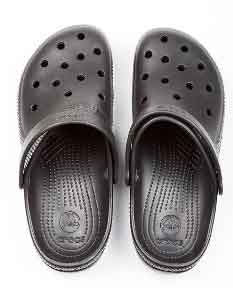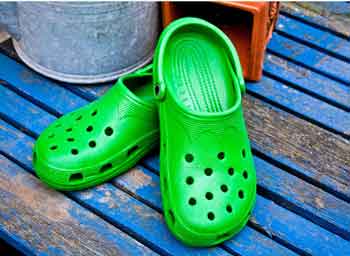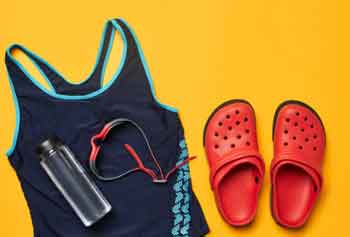Absolutely! Crocs could leave you with blisters on your feet and this happens as a result of friction between your feet and the Crocs amongst other things.
Reading through this article, you’ll get to know all of these underlying factors that could eventually lead to blisters on your feet.
All of these factors are not peculiar to Crocs, they could also be seen when it comes to shoes generally.

Without the shadow of a doubt, everyone (maybe not everyone) knows that just a blister would intermeddle with an individual’s daily activity (ies); keeping them uncomfortable.
This depends on the location of the blister though, especially when it is located around the feet (For a fact, this is where it most times occurs).
We all know what blisters are… pockets of fluids; sac-like, that form on an area of the body. These blisters may vary in size and could occur for different reasons.
One of such reasons is what I’d be addressing in this article. Other reasons could be as a result of a skin burn, an infection with a fungus, and perchance; bacteria, an insect bite, or a trauma.
In what ways can Crocs give you blisters?
Speaking of Crocs leaving you with blisters, it is noteworthy that just the wearing of Crocs is not what causes blisters, but certain situations surrounding the wearing of Crocs. Come along with me!
See the many different ways in which Crocs could leave you with blisters;
Friction
Yes, Friction! Many persons, because of the situation of their jobs, or whatever activity they are involved in, are required to be on their feet for several hours (standing or walking) and thus, mount pressure on their heels, soles, and toes.
The longer you are on your feet (on a row), the greater your risks of ending up with blisters; whether or not you’re wearing Crocs. This is a result of the friction that occurs.
This is not to say that all persons who are on their feet for several hours would end up with blisters.
Many times, these blisters result from poorly fitted shoes, in that footwear that fit too tightly or too loosely can begin to rub against the skin, leading to friction and by extension, the fluids begin to build up.
Moisture
Moisture; excessive moisture at that, as well as perspiration while wearing your pair of Crocs could activate the formation of blisters.
Not limited to Crocs, it is sore common amongst athletes, runners, especially, during summer.
Once there is moisture, there is the tendency of ending up with blisters on the feet.
Asides from all of these ways through which blisters could form as a result of putting on Crocs, they could as well develop after a sunburn, frostbite, an allergic reaction, chemical exposure (be it cosmetics or detergents), fungal infections, chickenpox, bacterial infection, herpes, and even dyshidrotic eczema.
What can you do to stop Crocs from giving you blisters?
This literally means preventing blisters, and preventing blisters has to do with tackling all of the underlying causes of it.
As I mentioned early on, friction is a major cause of feet blisters; hence, to prevent it, wearing a pair of properly fitted Crocs (not uptight and not loose) would do.
Put on thick socks
Another way is to shop for socks that draw off moisture and perspiration. Sometimes, having sweaty feet may be inevitable; hence, the need to usually put a pair of socks on.
This keeps the feet dry and helps reduce moisture. You may as well want to apply some foot powder to reduce sweaty feet.
You could as well use toe protectors or toe caps as they help cushion the toes from the shoe and prevent friction.
You can use an insole for your Crocs
If your Crocs or shoes, in general, seem to be loose, causing your feet to rub along with a specific area of the shoe, thus leading to blisters; purchasing and using an insole may provide you with extra padding and reduce friction.
Simply shop for insoles; they’re available on Amazon.
Knowing that certain cosmetics products (powder, lotion, or soap) could lead to you having blisters, simply avoiding such products reduces the likelihood of subsequent blisters. It’s just as simple!
Vaseline also helps
What about Vaseline? It behooves me to apprise you that Vaseline also works when it comes to preventing blisters.
Simply rub it on any of the areas where you don’t want blisters, the Vaseline helps reduce the friction and helps to lubricate your pair of Crocs.
In essence, tackling the underlying problems lowers the risk of ending up with blisters; dealing with a problem from its roots, so to speak.
What can you do when Crocs give you blisters?

When one has blisters, what first comes to mind is a home treatment. I mean, blisters are not often a serious health issue as they could heal up after a while; it all depends though a foot blister caused by friction would heal within a few days, just with home treatments.
Sad to say, some blisters do not respond to home treatment and are likely to worsen gradually.
If your blister causes you severe pain such that it restrains you from walking, seeing a Doctor would pay off as the whole case could degenerate if close attention isn’t paid to it.
If you as well feel nauseated or see symptoms of fever accompanying a foot blister, you should see a doctor immediately as this could be a sign of an infection.
At this, your Doctor could drain out the fluids in a bid to examine and determine the cause of the infection.
However, one may be tempted to pick at or burst a blister which could be really risky. Risky because the blister would be left open, and an open blister is open to infections.
Rather, the blister(s) should be left all alone as they’ll eventually harden, dry up and disappear.
But on the occasion that it leaves you uncomfortable, especially because of its size, you could safely drain the fluids instead of bursting them.
Here are a few DIY steps to properly drain blisters:
- Wash your hands thoroughly with warm water and antibacterial soap for at least 30 seconds
- With the aid of cotton wool, disinfect a needle (syringe) by rubbing alcohol.
- Clean the surface of the blister with antiseptic
- Carefully make a small puncture in the blister with the needle such that you’re able to drain out the fluids completely.
- Apply an antibacterial ointment or cream to the blister
- Cover the blister with a bandage or gauze as leaving it open could open it to infections
- Clean and reapply the antibacterial ointment daily, and change the bandages daily too.
Apart from the steps listed above, you could as well decide to dab some honey on the affected surface.
If honey is out of reach, you could try aloe vera gel or petroleum jelly as they have anti-inflammatory properties.
Are there Crocs that do not give blisters?
You’re probably on the lookout for Crocs that do not cause blisters. Well, let me first correct that notion; as
I mentioned at the beginning of this article, the wearing of Crocs is not what gives blisters, but the circumstances that surround it.
It could be a result of friction or moisture. So, the thought of Crocs causing blisters just on its own should be jettisoned.
I mean, Crocs were not designed to give you blisters, but to keep you comfortable.
What to do simply is to find your right size; not loose and not tight. Once you find your right size, properly fitted, follow the rest measures I recommended earlier, you’re good to go!
However, I have a number of Crocs you should try out; all you need do is to just ensure you get and wear what fits you perfectly.
See my Top 3!
Crocs Unisex-Adult Crocband Clog
As the name suggests, this pair could be worn by both men and women. It is sporty, stylish, and comfortable.
With amazing designs, this product comes in different colors, and guess what? It isn’t at all expensive; very much affordable.
Being a multi-use slipper, this particular product helps you look sophisticated, male and female alike, anywhere it is worn.
In fact, it boasts of durability, meaning that it lasts long, so far as it is properly maintained.
About blisters; this pair of Croc won’t give you blisters except you’ve purchased an oversize or an undersized pair, leading to friction, and then blisters.
This is why you should pay close attention to the size you’d be ordering. Remember, Crocs do not just give blisters. To get yours, see the link below.
Bistro Graphic Clogs
The Bistro Graphic Clogs is another amazing pair of Crocs that lasts long. Worn on different occasions (to the beach, pool parties, the garden, etc.), this product is as well non-slip and is durable.
One of the unique features this product has is the graphic design imprinted on it, making it slick and exceptionally beautiful.
However, you should properly maintain this pair as the graphics could begin to peel off when carelessly kept.
Again, this product is not a blister-causing pair. It will only leave you with blisters if there is too much friction, moisture, or what have you.
Therefore, to eschew friction, see all of the steps I have listed above and follow them. You will be glad you did. Would you like to get one? Hit the purchase link below already!
Classic Animal Print Clog
This pair of Crocs is suitable for use by both men and women. It could be worn at the beach, for a pool party, gym, shower, and for a walk.
As a matter of fact, it could be used by gardeners and other industry workers who are out in search of non-slip footwear.
Interestingly enough, it comes in a variety of colors and designs which means that you are free to select which design and color best suit your personality. It is designed in Snake, Zebra, and Leopard prints.
While placing your order for this pair of amazing Crocs, you should pay close attention to the size you are ordering so that you do not get an undersized or an oversized pair of Crocs which could in the short run, give you blisters.
See the link below to purchase yours!
Final Thoughts

Crocs would ordinarily not cause blisters. In fact, shoes, in general, do not cause blisters, but underlying factors such as friction, moisture, and size do.
When you wear an oversize or undersized pair of footwear, you are at the risk of ending up with blisters; hence, the need to always wear your proper shoe size.
I hope that you found this piece worthwhile and most importantly, helpful. Have you had blisters as a result of wearing a pair of Crocs?
How did you handle the situation? What preventive measures have you been taking to keep blisters at bay?
How effective has it been for you? I’d like to get answers to all of these questions in the comments section below as they will help in shaping my thoughts about the subject matter.
You could as well tell me what model of Crocs you wear and how fun it has been wearing them.
Overall, do not forget to share with me what you experienced after you followed the steps I recommended. I’d be awaiting your feedback in the comments.
Thanks for engaging!
This page may contain affiliate links.
To support the content and the knowledge I share here, I earn from qualifying purchases from Amazon at no extra cost to you.



